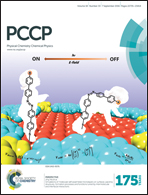Thermophysical properties of imidazolium tricyanomethanide ionic liquids: experiments and molecular simulation†
Abstract
The low-viscous tricyanomethanide ([TCM]−)-based ionic liquids (ILs) are gaining increasing interest as attractive fluids for a variety of industrial applications. The thermophysical properties (density, viscosity, surface tension, electrical conductivity and self-diffusion coefficient) of the 1-alkyl-3-methylimidazolium tricyanomethanide [Cnmim][TCM] (n = 2, 4 and 6–8) IL series were experimentally measured over the temperature range from 288 to 363 K. Moreover, a classical force field optimized for the imidazolium-based [TCM]− ILs was used to calculate their thermodynamic, structural and transport properties (density, surface tension, self-diffusion coefficients, viscosity) in the temperature range from 300 to 366 K. The predictions were directly compared against the experimental measurements. The effects of anion and alkyl chain length on the structure and thermophysical properties have been evaluated. In cyano-based ILs, the density decreases with increasing molar mass, in contrast to the behavior of the fluorinated anions, being in agreement with the literature. The contribution per –CH2– group to the increase of the viscosity presents the following sequence: [PF6]− > [BF4]− > [Tf2N]− > [DCA]− > [TCB]− > [TCM]−. [TCM]−-based ILs show lower viscosity than dicyanamide ([DCA]−)- and tetracyanoborate ([TCB]−)-based ILs, while the latter two exhibit a crossover which depends both on temperature and the alkyl chain length of the cation. The surface tension of the investigated ILs decreases with increasing alkyl chain length. [C2mim][TCM] shows an outlier behavior compared to other members of the homologous series. The surface enthalpies and surface entropies for all the studied systems have been calculated based on the experimentally determined surface tensions. The relationship between molar conductivity and viscosity was analyzed using the Walden rule. The experimentally determined self-diffusion coefficients of the cations are in good agreement with the molecular simulation predictions, in which a decrease of the self-diffusion of the cations with increasing alkyl chain length is observed with a simultaneous increase in viscosity and for the longer alkyl lengths the anion becomes more mobile than the cation.


 Please wait while we load your content...
Please wait while we load your content...